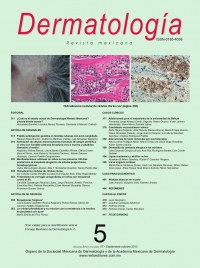Resumen
Resumen Las infecciones oportunistas causadas por hongos son una causa de muerte en individuos inmunodeprimidos, así como de infecciones nosocomiales relacionadas con catéteres y dispositivos médicos. En relación con estas últimas infecciones, está demostrado que los hongos tienen gran capacidad para formar biopelículas sobre estos materiales, lo que favorece su diseminación en el organismo. Además, este tipo de procesos facilita la aparición de resistencia hacia los antifúngicos. Por esta razón, es necesario conocer cuál es el origen, desarrollo y control de las biopelículas, así como los mecanismos de resistencia y las opciones de tratamiento dirigido a esta forma de organización microbiana. Palabras clave: biopelículas fúngicas, resistencia a antibióticos, biofilms, Candida sp, Cryptococcus sp.
Palabras clave: Candida sp, biopelículas fúngicas, resistencia a antibióticos, biofilms, Cryptococcus sp
Abstract
Abstract Opportunistic infections caused by fungi can be a cause of death in immunocompromised individuals and nosocomial infections related to catheters and medical devices. In relation to the latter infection has been shown that fungi have a great ability to form biofilms on these materials, which favors its dissemination into the body. In addition, this type of organization facilitates the emergence of resistance to antifungal agents. For this reason, it is necessary to know the origin, development and control of biofilms, and the mechanisms of resistance and treatment options targeting this form of microbial organization. Key words: fungal biofilms, antibiotic resistance, biofilms, Candida sp, Cryptococcus sp.
Keywords: Candida sp, antibiotic resistance, fungal biofilms, biofilms, Cryptococcus sp

